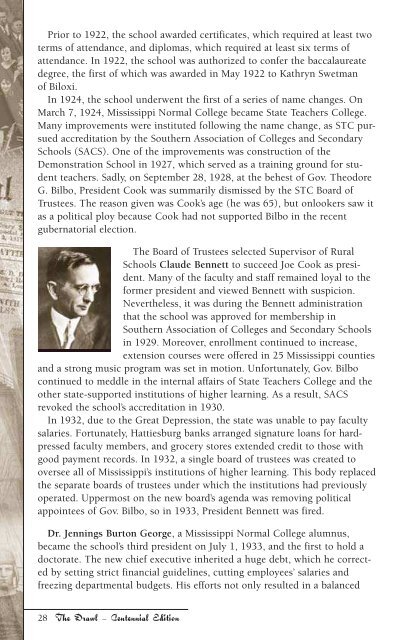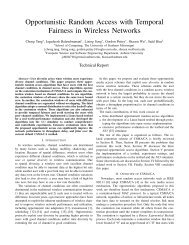The Drawl - Southern Miss Alumni Association
The Drawl - Southern Miss Alumni Association
The Drawl - Southern Miss Alumni Association
Create successful ePaper yourself
Turn your PDF publications into a flip-book with our unique Google optimized e-Paper software.
Prior to 1922, the school awarded certificates, which required at least two<br />
terms of attendance, and diplomas, which required at least six terms of<br />
attendance. In 1922, the school was authorized to confer the baccalaureate<br />
degree, the first of which was awarded in May 1922 to Kathryn Swetman<br />
of Biloxi.<br />
In 1924, the school underwent the first of a series of name changes. On<br />
March 7, 1924, <strong>Miss</strong>issippi Normal College became State Teachers College.<br />
Many improvements were instituted following the name change, as STC pursued<br />
accreditation by the <strong>Southern</strong> <strong>Association</strong> of Colleges and Secondary<br />
Schools (SACS). One of the improvements was construction of the<br />
Demonstration School in 1927, which served as a training ground for student<br />
teachers. Sadly, on September 28, 1928, at the behest of Gov. <strong>The</strong>odore<br />
G. Bilbo, President Cook was summarily dismissed by the STC Board of<br />
Trustees. <strong>The</strong> reason given was Cook’s age (he was 65), but onlookers saw it<br />
as a political ploy because Cook had not supported Bilbo in the recent<br />
gubernatorial election.<br />
<strong>The</strong> Board of Trustees selected Supervisor of Rural<br />
Schools Claude Bennett to succeed Joe Cook as president.<br />
Many of the faculty and staff remained loyal to the<br />
former president and viewed Bennett with suspicion.<br />
Nevertheless, it was during the Bennett administration<br />
that the school was approved for membership in<br />
<strong>Southern</strong> <strong>Association</strong> of Colleges and Secondary Schools<br />
in 1929. Moreover, enrollment continued to increase,<br />
extension courses were offered in 25 <strong>Miss</strong>issippi counties<br />
and a strong music program was set in motion. Unfortunately, Gov. Bilbo<br />
continued to meddle in the internal affairs of State Teachers College and the<br />
other state-supported institutions of higher learning. As a result, SACS<br />
revoked the school’s accreditation in 1930.<br />
In 1932, due to the Great Depression, the state was unable to pay faculty<br />
salaries. Fortunately, Hattiesburg banks arranged signature loans for hardpressed<br />
faculty members, and grocery stores extended credit to those with<br />
good payment records. In 1932, a single board of trustees was created to<br />
oversee all of <strong>Miss</strong>issippi’s institutions of higher learning. This body replaced<br />
the separate boards of trustees under which the institutions had previously<br />
operated. Uppermost on the new board’s agenda was removing political<br />
appointees of Gov. Bilbo, so in 1933, President Bennett was fired.<br />
Dr. Jennings Burton George, a <strong>Miss</strong>issippi Normal College alumnus,<br />
became the school’s third president on July 1, 1933, and the first to hold a<br />
doctorate. <strong>The</strong> new chief executive inherited a huge debt, which he corrected<br />
by setting strict financial guidelines, cutting employees’ salaries and<br />
freezing departmental budgets. His efforts not only resulted in a balanced<br />
budget, but each year of his administration ended with a<br />
small surplus in the treasury.<br />
On February 13, 1940, the school’s name was changed<br />
for the second time. Its new name, <strong>Miss</strong>issippi <strong>Southern</strong><br />
College, reflected the fact that it was no longer exclusively<br />
a teachers’ college. During World War II,<br />
enrollment plummeted to around 300 as students and<br />
faculty members joined, or were drafted into, military<br />
service. Both head football coach Reed Green and his<br />
assistant Thad “Pie” Vann served in the armed forces. Looking ahead to the<br />
end of the war, President George established a $35,000 trust fund to provide<br />
scholarships for returning veterans. He also proposed graduate work in education,<br />
home economics and music.<br />
But in January 1945, before any of his plans were implemented, the Board<br />
of Trustees declined to rehire Dr. George, giving no definitive reason for its<br />
action. <strong>The</strong> school is deeply indebted to President George, for it was his<br />
sound fiscal policies and managerial genius that steered it safely through<br />
both the Great Depression and World War II.<br />
Dr. Robert Cecil Cook (no relation to Joe Cook)<br />
became the institution’s fourth president following his<br />
discharge from the Army on July 6, 1945. President<br />
Cook, whose credentials as an educator were impeccable,<br />
placed academic development at the top of his agenda.<br />
During his tenure, the Graduate Studies division was created,<br />
and the Reading Clinic, the Latin American<br />
Institute and the Speech and Hearing Clinic were established.<br />
Greek presence on campus was increased, the<br />
band program was expanded, the “Dixie Darlings” precision dance team was<br />
formed and enrollment soared to more than 2,000. <strong>The</strong> athletic program was<br />
strengthened, as coaches Reed Green and Pie Vann returned from military<br />
service and resumed their former positions.<br />
Over the next two decades, the combined efforts of these two outstanding<br />
coaches brought national recognition to the <strong>Southern</strong> <strong>Miss</strong> football program.<br />
In December 1954, Cook became the first president to leave the office voluntarily,<br />
when he resigned the presidency to accept a position as vice president<br />
and general manager of the Jackson State Times, a<br />
new daily newspaper.<br />
Dr. Richard Aubrey McLemore was named acting president,<br />
effective January 1, 1955, and served in that<br />
capacity until August 17, 1955. Dr. McLemore, known to<br />
the students as “Dr. Mac,” had been a faculty member at<br />
MSC since 1938, and had served as professor of history,<br />
head of the social studies division and dean of the college.<br />
28 <strong>The</strong> <strong>Drawl</strong> – Centennial Edition w w w . s o u t h e r n m i s s a l u m n i . c o m 29

















